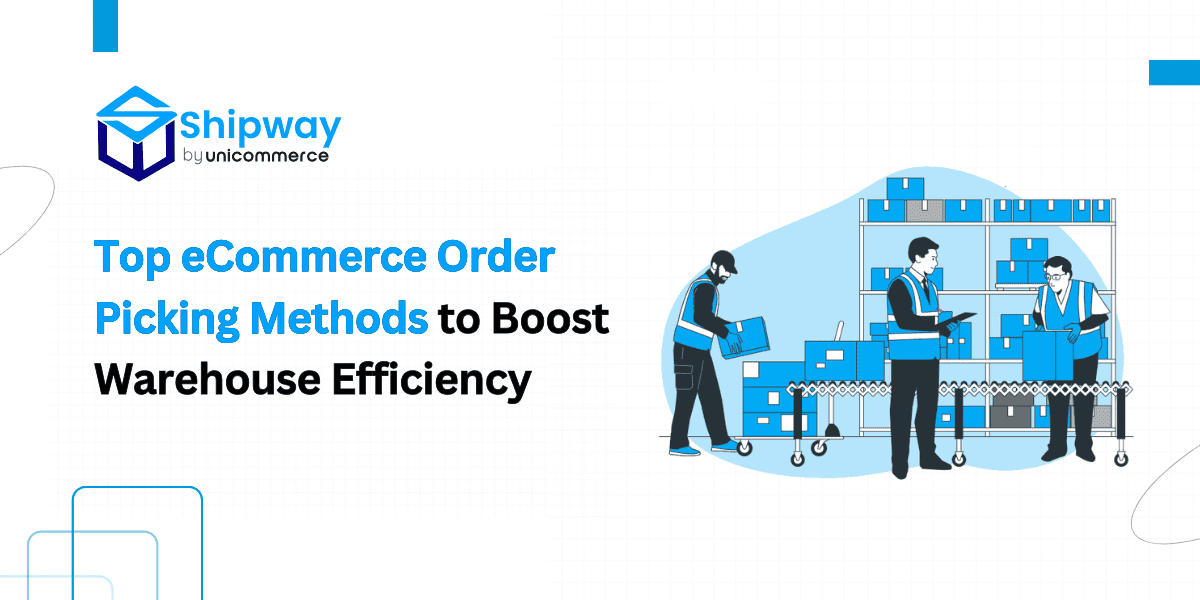Introduction to Order Picking in eCommerce
Warehouses play an important role in the success of any eCommerce company. It ensures a swift order fulfillment process for business operations. This is because today delivery speed has become a key factor in customer satisfaction. Also, the efficiency of order-picking methods directly impacts D2C brand growth.
In Ecommerce, order picking refers to the strategic process of selecting items from inventory to provide customer orders.
This process combines Warehouse Management Systems, technology, and automation to improve the business outputs. A well-optimized order-picking strategy leads to faster, more accurate deliveries. It further reduces the related errors and manages the business’s operational costs.
What is Order Picking in E-commerce?
Order picking is the process of retrieving products from warehouse inventory to fulfill customer-requested orders. It is the first and most critical step in the order fulfillment process. It directly influences both the delivery speed and accuracy in ecommerce.
Traditionally, warehouses depend on manual labor. In this workers that are also known as pickers retrieved those products from shelves. The quality of these pickers affected the success of the entire supply chain process. However, with advancements in technology, ecommerce businesses have transformed order-picking solutions. Now they use technology automation to improve the delivery speed and precision.
At present modern warehouses now integrate robotics, RF scanners, and AI-driven software to manage their business operations. These technologies have completely changed the complete order-picking process. However traditional methods continue to be widely used due to their effectiveness in all sorts of warehouse setups.
Why is Order Picking Important?
An efficient order-picking system provides different types of advantages to e-commerce companies. These are listed below:
1. Cost Reduction: Automation helps reduce warehouse operational expenses after properly minimizing labor-intensive tasks.
2. Faster Order Fulfillment: Automated picking lists optimize order grouping & assign tasks efficiently. It cuts down the order processing time.
3. Improved Order Accuracy: Accurate picking reduces errors. It further improves customer satisfaction and long-term loyalty.
4. Optimized Workforce Productivity: A well-structured picking system enables pickers to work efficiently. It further reduces errors and improves the overall warehouse performance.
Due to the above benefits, modern e-commerce stores continuously refine their order-picking strategies in order to increase business efficiency. Now, let’s explore some of the best order-picking methods used in eCommerce to manage order fulfillment operations.
Top Order Picking Methods for eCommerce
1. Single Order Picking
You will relate to this method, in case you have ever done grocery shopping with a list. Single-order picking is the simplest picking strategy of all the options. A warehouse worker also known as a picker usually retrieves items for one order at a time from warehouse shelves. After that, he brings them for packing. This technique is ideal for small warehouses that handle a low order volume.
Pros:
1. Simple and easy to implement.
2. Reduces errors by focusing on one order at a time.
Cons:
1. Inefficient for large-scale operations due to increased travel time.
2. Can slow down the fulfillment process.
2. Batch Picking
Imagine running a grocery store and picking items for multiple customers at once instead of making separate trips. That’s batch-picking in a nutshell. Instead of handling one order at a time, a picker retrieves similar SKUs for multiple orders simultaneously, reducing travel time.
It is ideal for warehouses that have frequent orders of the same items.
Pros:
1. Saves time by reducing repeated trips.
2. Enhances efficiency for small items and frequent orders.
Cons:
1. Not ideal for large or heavy items.
2. Requires an organized inventory and efficient sorting process.
3. Multi-Batch Order Picking
This is an advanced step in the earlier batch-picking method. Multi-batch order picking allows workers to collect multiple SKUs for different orders in a single trip. In this technique, instead of making several runs, pickers use multi-tier picking carts to gather products for multiple orders at once.
It is ideal for large warehouses that handle high-volume orders.
Pros:
1. Drastically reduces travel time.
2. Improves overall efficiency.
Cons:
1. Requires careful sorting and organization.
2. Workers may need additional training.
4. Zone Picking
Imagine a relay race in which each runner passes the baton to the next teammate. Similarly, in this method, the warehouse is divided into different zones, often organized by product type or storage medium such as racks, shelves, or bins and each picker is assigned a specific zone. Once items from one zone are picked, the order moves to the next zone.
It is an ideal option for large fulfillment distribution centers that handle different types of inventories.
Pros:
1. Reduces congestion and improves workflow.
2. Improved organization by assigning workers to specific areas.
Cons:
1. Requires a well-structured warehouse layout.
2. Can be slower than batch picking for smaller warehouses.
5. Wave Picking
Think of wave picking as an airport departure schedule. In this technique, orders are grouped into waves based on different parameters. These are priority, location, and shipping deadlines. It provides a warehouse option to optimize picking schedules.
Pros:
1. Helps coordinate picking with shipping schedules.
2. It is best for businesses to have multiple delivery deadlines.
Cons:
1. It requires a Warehouse Management System for proper scheduling.
2. Can be costly to implement.
6. Cluster Picking
Cluster picking utilizes technology-driven picking systems. It allows workers to pick multiple orders simultaneously and place them in separate bins. It eliminates the need for sorting later and speeds up the process.
This technique is best for those warehouses that use barcode scanners and automation.
Pros:
1. It reduces errors by making sure of an accurate item placement.
2. Saves time and improves order accuracy.
Cons:
1. Requires investment in scanning technology.
2. Workers need training to handle scanning equipment efficiently.
7. Pick-To-Light Systems
This advanced system guides pickers using LED lights that illuminate the exact location of an item and further reduce the guesswork. After properly following the lights, pickers can not retrieve the items faster and with greater accuracy.
This technique is ideal for those types of warehouses looking to improve picking speed and reduce human error.
Pros:
1. Increases picking accuracy.
2. Easy to integrate with existing WMS.
Cons:
1. Initial setup costs can be high.
2. Not as effective in dynamic warehouse layouts.
8. Voice Picking
Pickers receive verbal instructions from an Order Management System (OMS) using the help of wireless headsets. This hands-free approach is beneficial while handling bulky or hazardous items.
It is an ideal technique for Warehouses that deal with large, heavy, or hazardous materials.
Pros:
1. It reduces the related picking errors.
2. Improves efficiency by keeping workers’ hands-free.
Cons:
1. Requires investment in voice technology.
2. Training is needed for new employees.
9. Mobile Scanner-Based Picking
Pickers use mobile barcode scanners to scan items. This ensures proper accuracy before adding them to an order. The system helps identify mistakes in real time and optimizes picking routes.
Best For: Warehouses aiming for high accuracy in order fulfillment.
Pros:
1. Reduces human errors significantly.
2. Enhances order tracking.
Cons:
1. Requires a digital inventory management system.
2. Pickers need to be trained to use scanners effectively.
10. Collaborative Mobile Robots
In 2025 and further, Robots are going to change warehouse operations by assisting workers in transporting picked items. These robots autonomously look for the warehouse and further eliminate unnecessary travel for human workers.
Best For: Large eCommerce warehouses investing in automation.
Pros:
1. Increases efficiency and reduces travel time.
2. Works alongside existing order-picking methods.
Cons:
1. High initial investment.
2. Requires warehouse infrastructure adjustments.
Conclusion
At last, selecting the right order-picking process is important for managing e-commerce operations and ensuring proper order fulfillment. This is because as the backbone of any online business, proper order management directly impacts customer satisfaction. It also affects the delivery speed and overall operational success.
Modern order-picking methods have evolved to optimize supply chain operations using the help of advanced API integration and technologies. Automation, robotics, and intelligent warehouse management systems help minimize errors. It also reduces manual labor costs and improves overall growth. In this, choosing a picking method that matches both current operational needs and future business goals ensures long-term scalability.
A
How to Optimize the Order-Picking Method?
Optimizing order picking requires a combination of different processes, strategic planning, and the right technology. This is because a well-structured picking system not only improves accuracy. It also improves the overall warehouse productivity.
- Organized Storage – In this store SKUs are in clearly labeled racks, totes, or bins to make item retrieval easier for further use. It reduces the picking errors. An organized warehouse layout minimizes confusion and speeds up the entire process.
- Minimizing Travel Time – Businesses need to use automation tools like Vertical Lift Modules (VLMs) to optimize storage. It further reduces unnecessary movement. As a result, this makes the overall picking more efficient.
- Stock Replenishment – Keep high-demand items well-stocked and easily accessible to prevent delays.
- Strategic Zone Allocation – Arrange inventory zones so that frequently picked items are closer to pickers. It minimizes unnecessary travel and congestion.
Performance Tracking – One needs to establish KPIs to monitor order-picking efficiency, identify bottlenecks, and continuously refine processes for better performance.
How to Choose the Right Warehouse Order-Picking Method?
Selecting the right order-picking method depends on different factors. These are:- warehouse layout, order volume, SKU characteristics, and available labor & technology. There is no one-size-fits-all approach in ecommerce. As a result, businesses must customize their strategy based on the operational needs.
- Assess Order Volume & SKU Size – High order volumes may require advanced methods like batch or wave picking. Whereas smaller businesses can start with single-order picking.
- Evaluate Warehouse Layout – One needs to ensure the chosen picking method aligns with warehouse space and storage capabilities for maximum efficiency.
- Consider Automation & Technology – As businesses scale, integrating automation, voice picking, and robotics can improve speed & accuracy.
- Adapt & Scale Gradually – While single-order and batch-picking work well for most businesses, larger operations can transition to more sophisticated methods like wave picking or AI-driven automation for quick fulfillment.
After aligning the order-picking method with current operations and future growth plans, businesses can improve efficiency, reduce errors, and maintain a competitive edge.
You may also like…
10 Questions to Ask Before Choosing a Shipping Partner for Your E-commerce Business
Top 10 Questions to Ask Before Choosing a Shipping Company Setting up an e-commerce business is only the first step. Long-term success depends on...
read more7 Proven Ways to Improve Delivery Ecommerce Performance with Shipway
Delivering products swiftly and reliably has become a decisive factor for winning and retaining customers in ecommerce delivery. Fast delivery...
read moreTop 10 Logistics Companies in India for eCommerce (2025 List & Guide)
India’s eCommerce sector is booming, projected to reach USD 200–220 billion by 2026, driving an urgent demand for reliable logistics solutions. For...
read more




